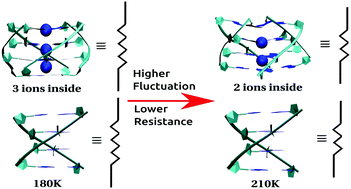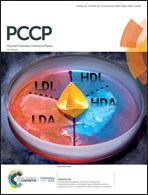Tuning molecular fluctuation to boost the conductance in DNA based molecular wires†
Abstract
Inherent molecular fluctuations are known to have a significant influence on the charge transport properties of biomolecules like DNA, PNA and proteins. In this work, we show ways to control these fluctuations and further demonstrate their use to enhance the conductance of two widely studied molecular wires, namely dsDNA (DNA) and G4 Quadruplex (G4-Quad). We quantify the molecular fluctuation in terms of the root mean square deviation (RMSD) of the molecule. In the case of DNA, we use temperature to control the fluctuations, while in the case of G4-Quad the fluctuations are tuned by the ions inside the pore. The electronic coupling between the bases of dsDNA and G4-Quad, which measures the conductance of these molecular wires, shows a non-monotonic behaviour with the increase in fluctuation. We find values of fluctuation which give rise to maximum electronic coupling and hence high conductivity for both the cases. In the case of DNA, these optimal fluctuations (∼2.5 Å) are achieved at a temperature of 210 K, which gives rise to an electronic coupling of 0.135 eV between the DNA bases. The optimal fluctuations in G4-Quad are achieved (∼7 Å) in a 4 base pair long system with 2 Na+ ions inside the pore, giving rise to an electronic coupling of 0.09 eV.



 Please wait while we load your content...
Please wait while we load your content...